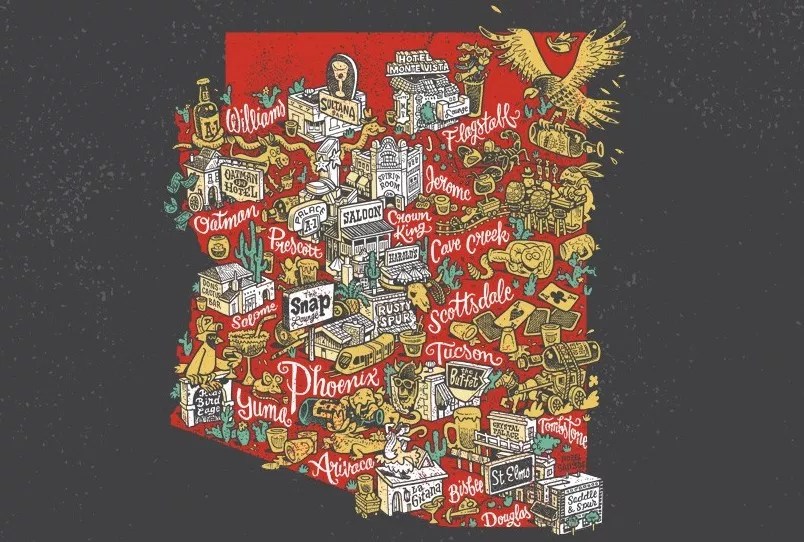
Kevin Cannon

Audio By Carbonatix
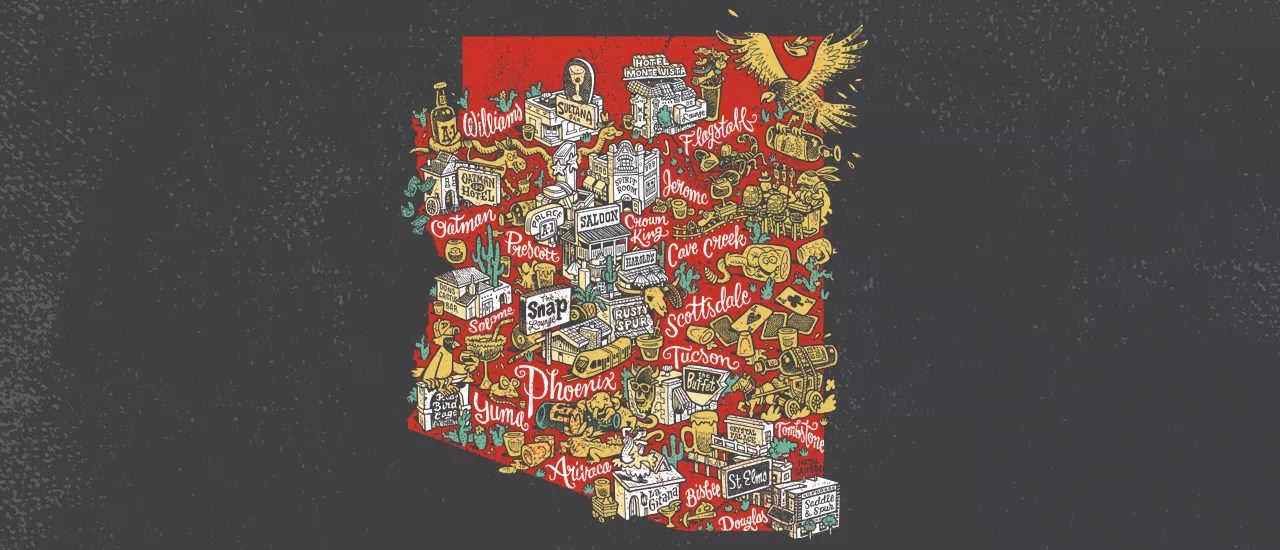
Kevin Cannon
Arizona has thirst written into its history, not just the arid landscape yearning for rain, but from the desire of its citizens: the hard-working and the lazy and the majority in between who want a stiff drink when the sun goes down. Our imbibing is often done in relative darkness — not merely in the gloom of night, but in the enveloping dimness of one of the 1,270 licensed establishments in the state dedicated to the ancient sport of tippling.
Some Arizona bars are consistently more inviting than others, and some do far more than others to channel the essence of the towns where they sit. A really successful gin-joint must do more than sling booze. It must also provide a chamber of companionship, a whiff of romance, a sense of temporary community, a free-fire zone of witticisms, and a spontaneous and slightly boisterous version of town hall democracy where every paying customer is treated like a potential friend and a fellow passenger on the journey of life.
“As soon as I enter the door of a tavern, I experience oblivion of care, and a freedom from solicitude,” said the British dictionary-maker Samuel Johnson, who would have been right at home on an Arizona barstool. “There is nothing which has yet been contrived by man, by which so much happiness is produced as by a good tavern or inn.”
Just as intoxication is the handmaiden of organized civilization, libations were enjoyed in Arizona long before its statehood. Missionaries brought in wine and mezcal under the watch of the Spanish crown, and Anglo miners and cowpunchers packed in distilling equipment for crude whiskey-making before the Civil War.
Our first alcohol regulations were written into territorial law by jurist William Thompson Howell in 1864 — the same year Alexander Lewin started Tucson’s first brewery, though the alkaline groundwater made his pilsner nearly undrinkable. Beer was less common than whiskey in frontier Arizona, wrote food historian Greg McNamee, primarily because a weaker variety of brew called “tiswin” could be made at home on the cheap. Whiskey was a better fit: It never spoiled and it was cheaper to transport in bulk.
“As soon as I enter the door of a tavern, I experience oblivion of care, and a freedom from solicitude.”
Only Arizonans of a distinguished age can now recall the old A-1 brand of beer brewed on Madison Street in Phoenix. Founded by the Fenster brothers after the repeal of Prohibition, the Arizona Brewing Company shipped its distinctive cans to groceries all around the state in the postwar boom years when tract homes bubbled up around the Valley. Its advertising slogan: “Which one? A-1!” The sales team also sent around Western-themed art featuring cowboys and cactus to decorate Arizona’s dingy taverns, and the Suns indefatigable play-by-play man Al McCoy was encouraged to shout “Good! Like A-1 beer!” on a player’s successful basket.
The expansion of national brands in the early 1960s forced the hometown brew into a noteworthy decline in quality and reach. The wrecking crew was led Cindy McCain’s father, Jim, a driven salesman who won the license to distribute Anheuser-Busch’s beer on the condition of exclusivity. By the time future Senator John McCain came on in 1981 as vice president of public relations, A-1 had all but vanished from the taps.
Not everything about bar drinking has been great for Arizona, of course. Hard-drinking mining towns of the 19th century had a reputation for rape, murder, and all other kinds of misery, a violent tradition that lingers today. Aggressive peddling of liquor to the Native Americans has a sordid heritage. Drunk-driving accidents often trace their roots to bar overconsumption, and Arizona’s car-happy culture makes it worse: There were 232 DUI-related fatalities here in 2015, comprising about a third of all deadly accidents.
We will not gloss over the reality: Thousands of Arizona citizens wind up in rehab, jail, or the grave because of the lure of this potentially dangerous friend. The unwritten history of all the human interaction that has taken place inside Arizona’s bars contains capacious volumes of happiness, laughter, and friendship, but also loneliness, rage, and despair.
Our determinative factors amounted to two: character and longevity. Nothing too new, and nothing too contrived.
So what makes a truly classic Arizona bar – one that captures the essence of the Grand Canyon State? Our determinative factors amounted to two: character and longevity. Nothing too new, and nothing too contrived. Just as the best cocktails are limited in their ingredients (the pseudoscience of mixology is a money-sucking myth), we also aimed for simplicity in this concoction.
To qualify as an iconic Arizona bar, the establishment has to have deep roots in the community – a place that’s seemingly been there forever – as well as that intangible feeling that a visitor gets from the bric-a-brac on the shelves, the ambient music on the speakers, the bartender’s personality, and the welcoming air from the crowd of regulars that they’ve just walked (or stumbled) out of a memorable place.
Discerning readers will see this final list tends favor dives and other proletarian joints. This was not by design. We could find very few bars in Arizona catering to an upscale crowd that passed the longevity test.
Perhaps this means that a scruffy taphouse with a dash of local personality may have more economic staying power than even the most well-heeled of spiffy boites, despite the low prices and tendency to attract law enforcement attention.
“Bars have an odd relationship to history,” wrote Ian Frazier. “Generally they spring up for a moment, provide a setting for all that transpires when people drink, close down without warning, and become a copy shop or similar place containing no clue of what used to be there.”
In the Valley alone, recalls historian Jon Talton, the vanished are a like roll call of honor: Velvet Hammer, Mecca, Kren’s, the Pueblo, Ivanhoe, Phone Booth, Smuggler’s Inn, Clown’s Den, Chauncey’s, Mister Fat Fingers, Velvet Hammer, Kemo Sabe, Garnet Lounge, Blue Grotto, Navarre’s, the Islands, Chez Nous. All a part of history’s hangover. Those listed below are the ones that endured.
Perhaps there’s a bigger moral here: The ability to take the punches, stay focused, remember your friends, and keep dragging yourself back to work in the morning is what it takes to win in the long run, like the alcohol-soaked heroes of William Kennedy’s Albany novels.
We’ll talk about this theory over a round. Meantime, here’s mud in your eye, partner.
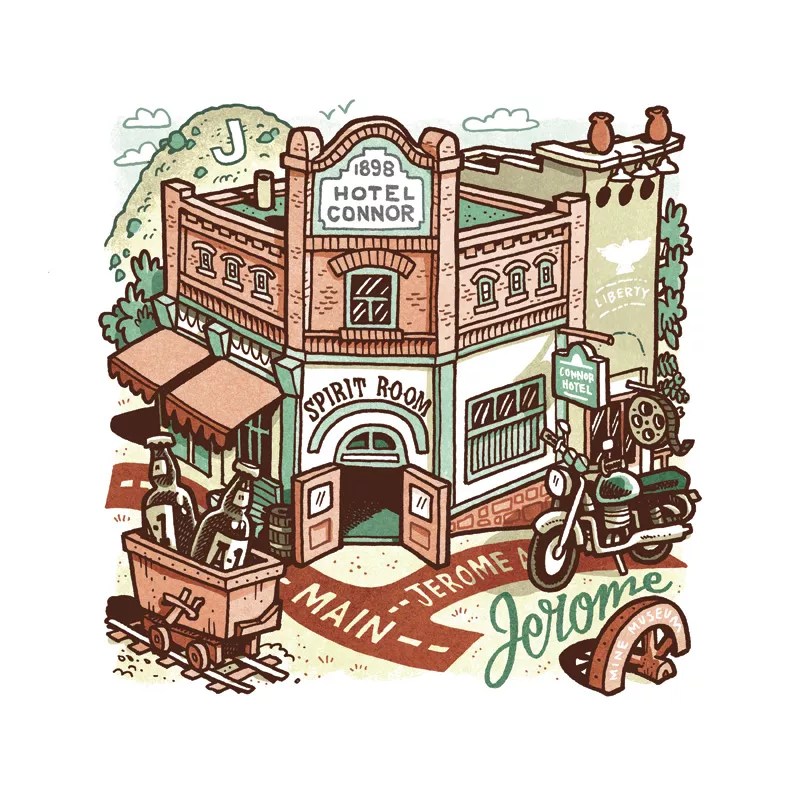
Kevin Cannon
Spirit Room
166 Main Street, Jerome
928-634-8809
Local musicians keep it bumping here in one of the state’s most evocative dead mining towns, though you might have to contend for bar space with the crowds of aging motorcyclists who make this a destination on weekends. Who can blame them? The serpentine road up Highway 89A is spectacular, the town of Jerome has hillside-clinging charm, and the cloud-and-shadow views of the Verde Valley are like a painting from the Hudson River School. Though the hall seems big, its gets packed quick into the third set of Janis Joplin covers and the room starts to stink of old sweat and leather. Getting caught up in the fun is all too easy here; if you feel too woozy to make the descent, take a room at the Connor Hotel right upstairs and pass out to the thump of reverberating bass.
Don’s Cactus Bar
66745 U.S. Route 60, Salome
928-859-3547
The author’s grandparents used to stop at this roadside joint for a cold one in the 1930s when they would go to visit relatives on a watermelon farm on the Colorado River. Salome is still an inviting highway stopover, memorably named for the duplicitous floozy dancer of the New Testament — the town’s motto is “Where She Danced” — and former home of the also-memorably-named gas station owner Dick Wick Hall, who used to brag he was the highest-paid humorist in the country after excerpts of his tall tales from the local newspaper found their way into the Saturday Evening Post. The original building from 1932 burned down not long ago, but has been rebuilt. For what it’s worth, the food here is unexpectedly excellent.
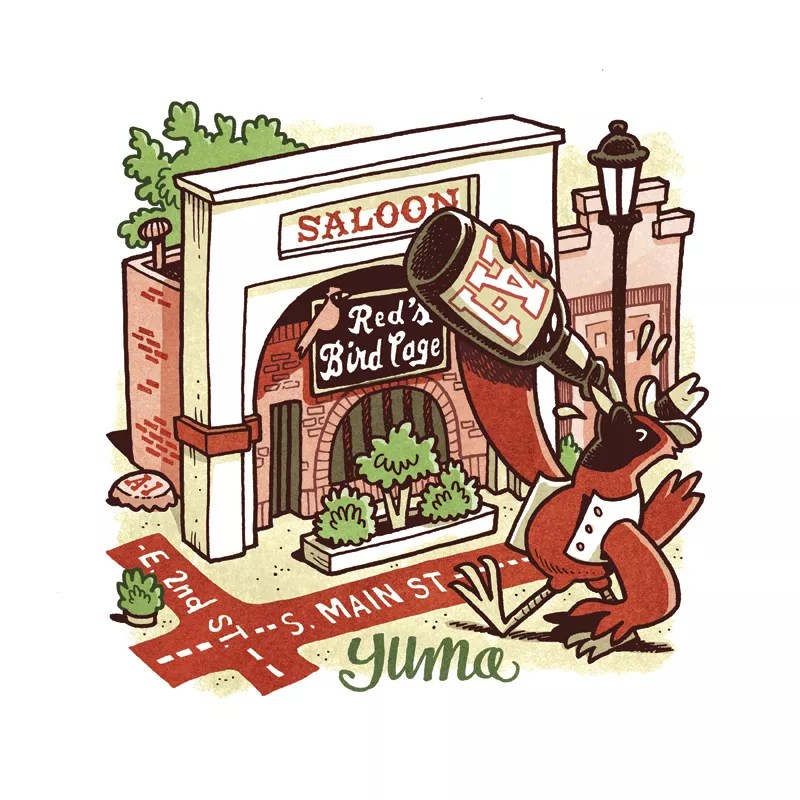
Kevin Cannon
Red’s Bird Cage
231 South Main Street, Yuma
928-783-1050
Descend a few steps below street level, notice the old shoeshine chair on the patio, and proceed into the cave-like interior of one of the few local treasures of this sweltering capital of agribusiness. See the photo on the wall of a smiling man surrounded with three lovely young women, looking like Big Daddy in a revival of Cat on a Hot Tin Roof. That’s C.C. “Red” Rambo, the founder, who used to own a place over the California line but moved it here in 1974, turning the former home of the Western Union telegraph office into a Gay Nineties-style pub that the Yuma Daily Sun called “barely respectable,” with a touch of irony. There were blossoms of wrought iron, a 1781 stained-glass window from a British pub, red wallpaper befitting a French bordello, a bar made partly of railroad trestles, regular acts featuring B-list performers from Vegas shows, and a bidet in the women’s room. Red’s has a coating of age on it since the glory days, but C.C.’s widow, Rea, keeps the place going for a hardcore bunch of regulars.
Harold’s Cave Creek Corral
6895 East Cave Creek Road, Cave Creek
480-488-1906
This barn-like hall was originally built in the name of an old Arizona tradition: getting a piece of the massive federal largess that’s flowed in here through the years. The workers who built the Bartlett Dam in the late 1930s needed a nearby place to spend their paychecks and forget their cares. An entrepreneur named Johnny Walker was there to help them with a place he called the Corral Bar. A promoter named Harold Gavagan bought it a few years later, filled it with honky-tonk gimcracks, brought in some country-and-western bands and called it a “wild west” bar, even though very few actual ranchers were among the customers. Sports plays on the TVs and there’s off-track betting. It’s worth seeing how Arizona looks at itself in a mirror and reflects itself back to the rest of the world.
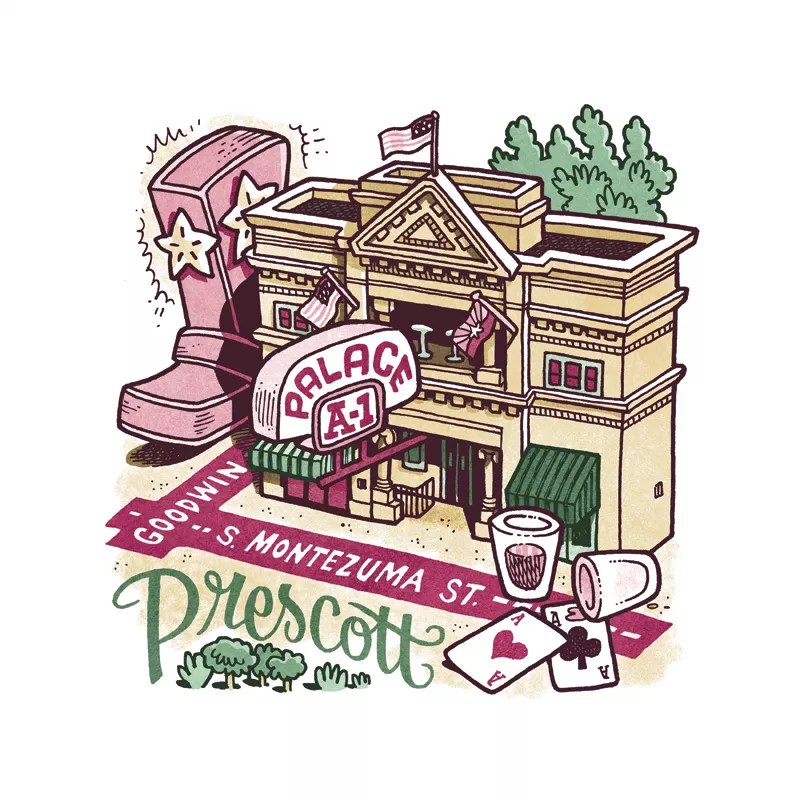
Kevin Cannon
The Palace
120 South Montezuma Street, Prescott
928-541-1996
Anchoring the western end of the state’s most graceful courthouse is a line of bars called Whiskey Row. The monarch of them is The Palace, operating since 1877, making it the strongest contender for the state’s oldest operating saloon, a title that gets fuzzy when periods of closure and reconstruction are taken into account. The gunfighter Doc Holliday claimed to have won $10,000 at the poker tables here. A fire leveled it in 1900, but patrons carried the hand-carved oak bar away from the flames and kept drinking. Rebuilt the next year and renovated again two decades ago, The Palace shows off a handsome tin ceiling and multiple historic photos on the wall. One now-embarrassing feature of the bar’s history: It was a social gathering spot for the “Smoki,” a bunch of white businessmen who dressed up like Hopi Indians as a part of the pageantry surrounding the Frontier Days Rodeo. Belonging to this group was a ticket to local influence that dated to 1921. The ceremonial mimicry, including a phony “snake dance,” died out amid Native American protests two decades ago. Today the hokiest activity at The Palace is a New Year’s Eve “boot drop” featuring a 6-foot-tall cowboy boot lit up with colored lights and lowered from the ladder of a fire engine.
St. Elmo Bar
36 Brewery Avenue, Bisbee
520-432-5578
Let the tourists have the art galleries and photogenic sidewalks of Tombstone Canyon; you’ll take the distinctly rougher terrain of Brewery Gulch in downtown Bisbee, where St. Elmo Bar has never cared much about what anyone thinks. It was here in 1902, long before you, and many prior generations of brawls, low-rent love affairs, and yelling matches have sparked up under its red neon sign. Its license was only the 20th issued in Arizona, and it covered the three basic vices of liquor, gambling, and prostitution. The last of these was practiced upstairs and today’s bathroom doors are said to have originally swung in the doors of the ladies’ cribs. Though the open-pit copper mines got mothballed in the 1970s and big paychecks are no longer routinely blown through before 2 a.m., the atmosphere still gets coarse and the bad-breath smell gets thicker on weekends. Leaving early isn’t the worst idea.
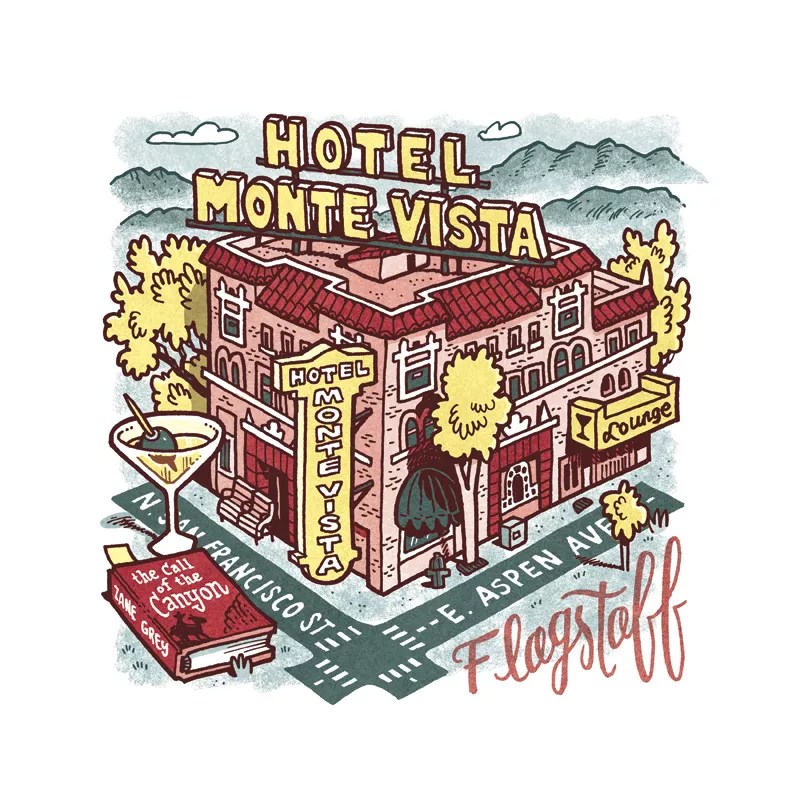
Kevin Cannon
Monte Vista Cocktail Lounge
100 North San Francisco Street, Flagstaff
928-779-6971
A cherished bit of folklore about the Hotel Monte Vista holds that scenes from Casablanca were filmed here. It isn’t true. Yet much more has happened in these walls that never got filmed. Dime novelist Zane Grey, author of Call of the Canyon and many other florid oat operas set in Arizona, helped put up the seed money to build it in 1926 — along with the taxpayers of Flagstaff via a municipal bond. The lower-level cocktail lounge almost certainly poured booze on the sly during Prohibition with the winking knowledge of the cops. A pioneering women broadcaster, Mary Costigan, ran a radio show from room 105, and Phoenix television station KTVK used to keep a Northern Arizona bureau here, too. The Monte V is a friendly and unpretentious place with a few video games, a couple of local toughs at the bar, and a few Colorado River runners at the tables. You’ll always have Flagstaff.
The Buffet
538 East Ninth Street, Tucson
520-623-6811
Tucson’s oldest operating bar got its license in 1934 after the end of Prohibition and has been serving up jumbo beer and hot dogs to an eclectic mix of railroaders, hepcats, U of A students, artist manques, and ne’er-do-wells ever since. The interior is coated with indecipherable graffiti, and the fragrance is best described as the residue of unwritten history. Cocktails are served in pint glasses. Appropriately enough, there are no windows. Everybody squints when somebody opens the front door to bright sunlight. The Buffet is also a short walk from two of the town’s other classic bars populated by Baja Arizona intelligentsia — The Shanty and the Surly Wench — making it a perfect ending-up place before the rideshare arrives.
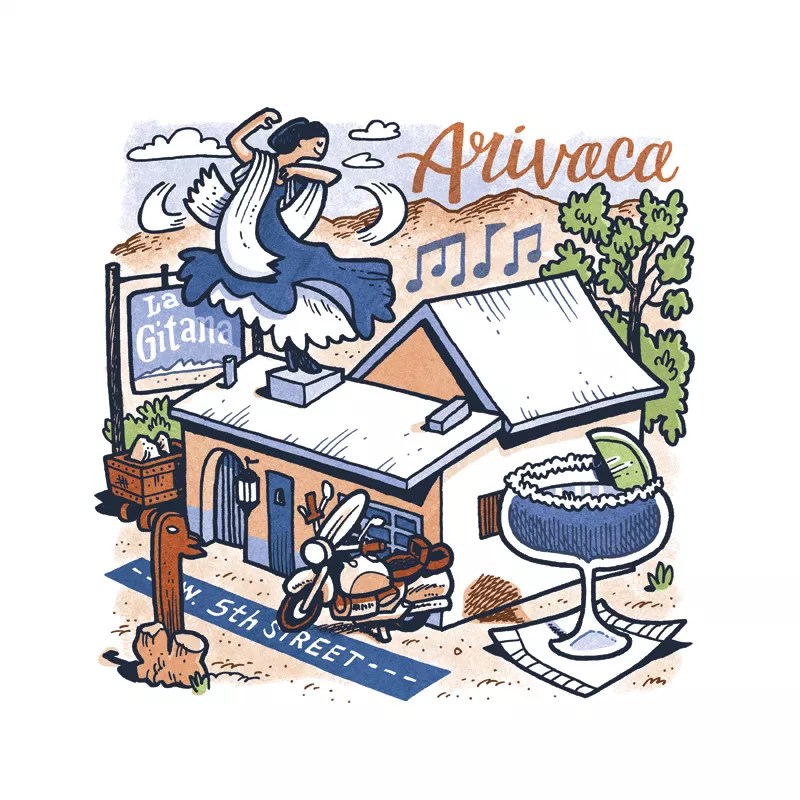
Kevin Cannon
La Gitana Cantina
17201 West Fifth Street, Arivaca
520-398-0810
A good tavern will really make you feel like a part of things. They take that mandate quite literally here at La Gitana (“The Gypsy”), where the surface of the mesquite bar is sealed with a lacquer containing the cremated remains of four deceased customers. Such is the loyalty inspired by this converted 1880s dance hall located in a countercultural town just a few miles north of the Mexican border. It’s the only bar in town, so be nice, even if the place has a historic reputation for mayhem, confirmed by a few bullet holes in the wall alongside the portraits of the outsized local characters who held court in this watering hole. The presence of multiple off-duty agents from the U.S. Border Patrol — which maintains a sizable force in the area — keeps things nice and peaceful these days.
The Snap Lounge
1516 West Camelback Road
602-222-3551
Work with us on this one. The Snap Lounge looks nondescript to the uninitiated eye: a single room with four pool tables and a DJ booth on a blah stretch of Camelback. Why is this an iconic bar? Look to the people for an answer: The clientele is predominately Native American, and this is the last of a great tradition of “Indian bars.” A few used to operate in the downtown neighborhood known as The Deuce; the rest scattered elsewhere in the Valley. Their names are legion, their histories mainly forgotten: Lil’s, The Esquire, Can-Can, Ponderosa. While alcohol and the Native American have had a long and tortured relationship, the regulars at the Snap are a friendly mingling of Apache, Hopi, Navajo, and Tohono O’odham, with linguistic and historic rivalries pushed aside. The drinks here are simple and stiff, the conversation lively. Trivia: This unassuming bar is also the No. 1 consumer of Budweiser in the state, according to the Arizona Liquor Association.

Kevin Cannon
Dollar Bill Bar
181 Main Street, Oatman
928-768-4408
Remember that crazy night you still talk about, even though the events are a little hazy? This saloon still dines out on the story of March 29, 1939, when the actors Clark Gable and Carole Lombard supposedly spent the first night of their honeymoon in a room upstairs to evade photographers at the courthouse in nearby Kingman. Evidence indicates the couple drove immediately back to Los Angeles after the wedding for an event the next morning, but the hotel still claims that disputed night as well as the actors’ ghosts for good measure (nothing like a purported haunting for marketing purposes). The other gimmicky draw to this bar off the old Route 66 is the cash attached to the walls: about $160,000 in dangling dollar bills. Most patrons can’t resist the urge to staple one there, too, along with a signature and a date. Alas, canoodling couples can no longer do the Gable/Lombard thing in the upstairs rooms: The fire marshal declared them uninhabitable in 2004. Ghosts only, please.
Saddle & Spur Tavern
1046 G Avenue, Douglas
520-364-4481
The playwright Thornton Wilder needed a little creative rejuvenation and he didn’t feel like spending more time in an artists’ colony. So he hit the road not knowing his destination. On May 30, 1962, his Thunderbird convertible broke down on U.S. 80 just east of Douglas. While he waited for it to get fixed, he checked into the Gadsden Hotel on the main drag of what was then a smelter town for the mighty Phelps Dodge Corporation. He spent his nights drinking in this bar, chatting with locals, and decided that this was just the place, a part of the country that seemed imported from the Book of Genesis and which he described to a friend as “overwhelmingly beautiful.” Wilder set up a typewriter in a rented room, played Mozart string quartets on a portable record player, and began the book titled The Eighth Day that would win him the National Book Award. People in the hotel bar started calling him “doc” and “professor,” and they liked him, even though he was always mysterious about what he did for a living. Today, this bar is decorated with cattle-brand markings, and inspiration and companionship are still easy to find.
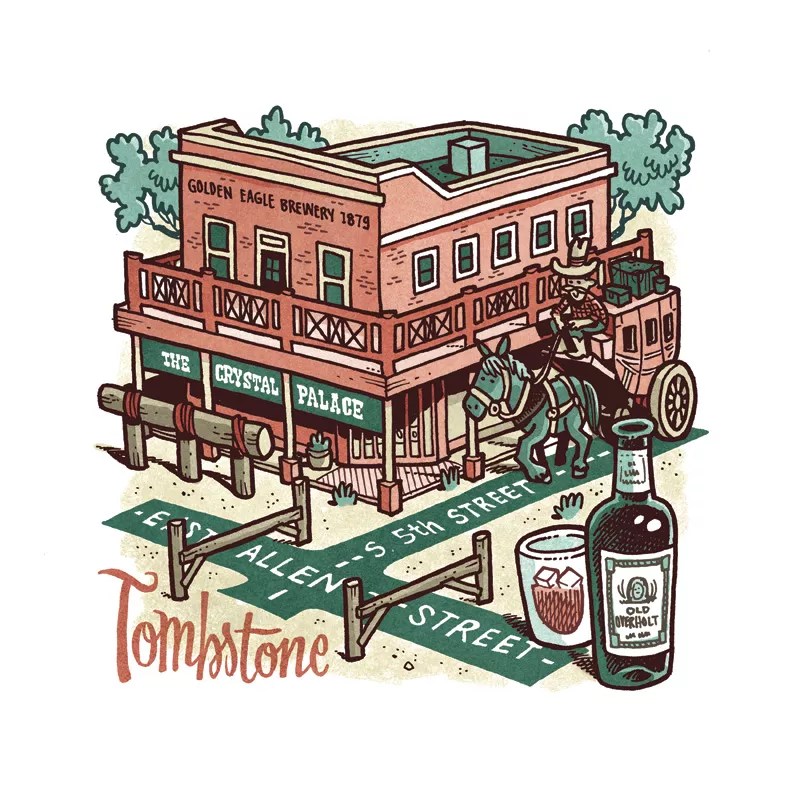
Kevin Cannon
Crystal Palace Saloon
436 East Allen Street, Tombstone
520-457-3611
While it may be true that most of this town is a third-rate theme park for European cowboy fetishists, there are a few things here that don’t suck. One is the Goodenough Mine tour where you can walk through the subterranean chambers where migrants used to hack silver from the walls. The other is the Crystal Palace, which used to be a lace-and-cutlery kind of place serving the bourgeoise class, considered respectable enough for Deputy U.S. Marshal Virgil Earp to keep his offices upstairs, and occasionally descend the stairs to play faro and cards. He got shot in the back just down the street after he and his younger brother Wyatt shot it out with accused stagecoach robbers in a nearby alley, bequeathing a lasting tourist industry to this town. “Mythologized beyond recognition, the sordid little saga of Tombstone unfolded in a haze of black powder, mysterious ‘suicides,’ and alcoholic fumes,” wrote historian Thomas Sheridan. The Crystal Palace has survived all this time and still serves up booze from a towering back bar with mirrors. Owner Kim Herring added a kitchen in 2007. The fare is standard bar food like pizza, burgers, and steaks. The outside got a renovation this year; you can now look at the faux gunfights from an outside deck while sipping an Old Overholt whiskey, which happened to be Doc Holliday’s favorite brand. Gone from the back room, however, are the Texas Hold ’em games. Herring got rid of them because of the legalities. Somewhere, Virgil Earp is frowning.
Crown King Saloon
7219 Main Street, Crown King
928-632-7053
Here’s another dubious claimant to the oldest operating bar in Arizona, though this one comes with an asterisk. The two-story building with a picket fence balcony was a butcher shop located in the nearby settlement of Oro Belle before it was disassembled and moved to its current location in 1906. Though it lies 27 miles away from the nearest paved road, Crown King was once the center of considerable wealth from the gold mines in the southern Bradshaw Mountains — an impossibly steep railroad used to haul the ore to Prescott. Today, most of the crowd at the bar consists of off-roaders seeking refreshment at the end of their Bradshaw excursions and a smattering of locals from the village, pop. 133.
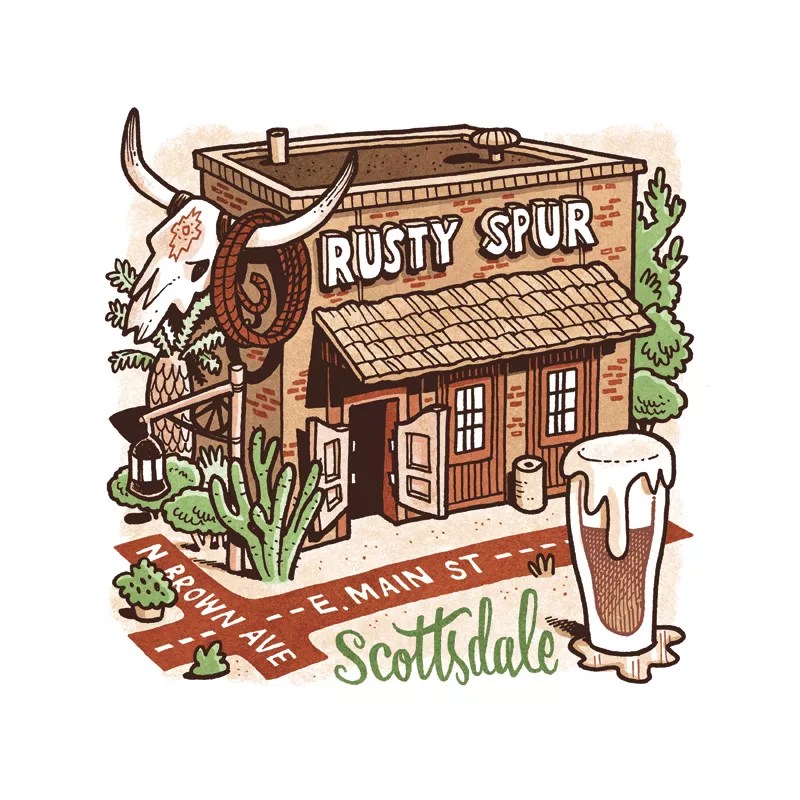
Kevin Cannon
Rusty Spur Saloon
7245 East Main Street, Scottsdale
480-425-7787
The history of modern Scottsdale is written in three parts. The founding era began in 1888 when U.S. Army chaplain Winfield Scott purchased some land next to the new Arizona Canal to grow citrus trees, and a little market village sprung up around him. The second era happened after World War II when the first mayor, Malcolm White, began to hype up a mythical cowboy past with the slogan “The West’s Most Western Town,” encouraging a discretionary economy founded on snowbird resorts and cowboy geegaw emporiums. The third era, beginning in the mid-1980s and continuing into today, featured the ridiculous hurl of luxury homes, stucco strip malls, and golf courses far to the north of Pima Road, and the carnivalization of its sedate downtown into a nightclub-choked spectacle of the drunken and the cosmetically enhanced. The Rusty Spur is a holdout from Scottsdale’s Second Empire period of growth, and well worth the trip for the wagon wheel chandelier, the deer heads, the antlers, the peanut shells on the floor, and the barstools shaped like hoochie-girls’ butts. The ersatz Bonanza message is as flat-out phony as a lot of other elements of Scottsdalia, but that’s part of the deal in this town.
Sultana Bar
301 Historic Route 66, Williams
928-635-2021
Like a true aristocrat in the midst of pretenders, the Sultana is a genuine find among all the faux-Route 66 junkola in Williams. It predates the highway economy and traces its roots to a time when ranching, logging, and the Santa Fe Railroad were the big games in town. The rusted neon sign outside depicts a martini glass and the dubious promise that this gin joint is “world famous.” If it isn’t, it should be, because the Sultana has rough-hewn style that cannot be re-created, down to the wood floors. A few tunnels underneath were supposed to have been used for opium storage in the early part of the century, and then for booze caches during Prohibition. A stuffed cougar frozen in a hunting pose stands watch over the bar. More illicit deeds went down at the Sultana after World War II — a police chief was shot in the alley — and a slight feeling of edginess never went away after that. A connecting passage takes you into a theater next door where the first generation of silent movies used to be screened before World War I. Now, it’s a hall rented out for weddings and other special events. Wander through with a drink in hand, wondering about the people who have passed through, of whom you are now one.
(Correction: The original headline written by the editor had the wrong number of bars covered in the story.)